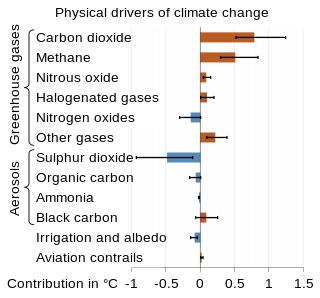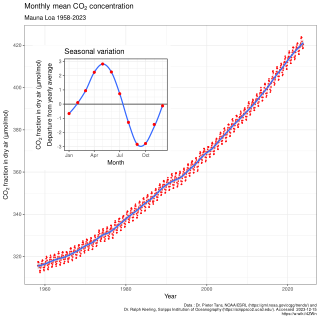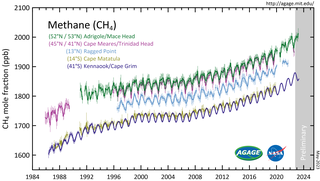Related Research Articles

The scientific community has been investigating the causes of climate change for decades. After thousands of studies, it came to a consensus, where it is "unequivocal that human influence has warmed the atmosphere, ocean and land since pre-industrial times." This consensus is supported by around 200 scientific organizations worldwide, The dominant role in this climate change has been played by the direct emissions of carbon dioxide from the burning of fossil fuels. Indirect CO2 emissions from land use change, and the emissions of methane, nitrous oxide and other greenhouse gases play major supporting roles.

Global Warming Potential (GWP) is an index to measure of how much infrared thermal radiation a greenhouse gas would absorb over a given time frame after it has been added to the atmosphere. The GWP makes different greenhouse gases comparable with regards to their "effectiveness in causing radiative forcing". It is expressed as a multiple of the radiation that would be absorbed by the same mass of added carbon dioxide, which is taken as a reference gas. Therefore, the GWP has a value of 1 for CO2. For other gases it depends on how strongly the gas absorbs infrared thermal radiation, how quickly the gas leaves the atmosphere, and the time frame being considered.

The carbon cycle is that part of the biogeochemical cycle by which carbon is exchanged among the biosphere, pedosphere, geosphere, hydrosphere, and atmosphere of Earth. Other major biogeochemical cycles include the nitrogen cycle and the water cycle. Carbon is the main component of biological compounds as well as a major component of many minerals such as limestone. The carbon cycle comprises a sequence of events that are key to making Earth capable of sustaining life. It describes the movement of carbon as it is recycled and reused throughout the biosphere, as well as long-term processes of carbon sequestration (storage) to and release from carbon sinks.

Global cooling was a conjecture, especially during the 1970s, of imminent cooling of the Earth culminating in a period of extensive glaciation, due to the cooling effects of aerosols or orbital forcing. Some press reports in the 1970s speculated about continued cooling; these did not accurately reflect the scientific literature of the time, which was generally more concerned with warming from an enhanced greenhouse effect.
The Center for the Study of Carbon Dioxide and Global Change is a 501(c)(3) non-profit organization based in Tempe, Arizona. It is seen as a front group for the fossil fuel industry, and as promoting climate change denial. The Center produces a weekly online newsletter called CO2Science.
The Global Warming Petition Project, also known as the Oregon Petition, is a group which urges the United States government to reject the Kyoto Protocol of 1997 and similar policies. Their petition challenges the scientific consensus on climate change. Though the group claims more than thirty-thousand signatories across various scientific fields, the authenticity and methods of the petitioners as well as the signatories' credentials have been questioned, and the project has been characterized as a disinformation campaign engaged in climate change denial.
Craig D. Idso is the founder, president and current chairman of the board of the Center for the Study of Carbon Dioxide and Global Change, a group which receives funding from ExxonMobil and Peabody Energy and which promotes climate change denial. He is the brother of Keith E. Idso and son of Sherwood B. Idso.
Keith E. Idso is a botanist and vice president of the Center for the Study of Carbon Dioxide and Global Change. He is the brother of Craig D. Idso and son of Sherwood B. Idso. He received his B.S. in Agriculture with a major in Plant Sciences from the University of Arizona and his M.S. from the same institution with a major in Agronomy and Plant Genetics. He completed his Ph.D. in Botany at Arizona State University. In 1994, Idso, along with his father, published a review paper on the topic of increased CO2 levels and their effects on plant growth. The paper concluded that not only did other factors not diminish the ability of CO2 to increase plant growth rates, that "the data show the relative growth-enhancing effects of atmospheric CO2 enrichment to be greatest when resource limitations and environmental stresses are most severe." As of 1999, he was teaching biology in the Maricopa County Community College District as an adjunct professor, a post to which he was appointed in 1996.

The Keeling Curve is a graph of the accumulation of carbon dioxide in the Earth's atmosphere based on continuous measurements taken at the Mauna Loa Observatory on the island of Hawaii from 1958 to the present day. The curve is named for the scientist Charles David Keeling, who started the monitoring program and supervised it until his death in 2005.

Charles David Keeling was an American scientist whose recording of carbon dioxide at the Mauna Loa Observatory confirmed Svante Arrhenius's proposition (1896) of the possibility of anthropogenic contribution to the greenhouse effect and global warming, by documenting the steadily rising carbon dioxide levels. The Keeling Curve measures the progressive buildup of carbon dioxide, a greenhouse gas, in the atmosphere.
The faint young Sun paradox or faint young Sun problem describes the apparent contradiction between observations of liquid water early in Earth's history and the astrophysical expectation that the Sun's output would be only 70 percent as intense during that epoch as it is during the modern epoch. The paradox is this: with the young Sun's output at only 70 percent of its current output, early Earth would be expected to be completely frozen, but early Earth seems to have had liquid water and supported life.

In Earth's atmosphere, carbon dioxide is a trace gas that plays an integral part in the greenhouse effect, carbon cycle, photosynthesis and oceanic carbon cycle. It is one of several greenhouse gases in the atmosphere of Earth. The current global average concentration of carbon dioxide (CO2) in the atmosphere is 421 ppm as of May 2022 (0.04%). This is an increase of 50% since the start of the Industrial Revolution, up from 280 ppm during the 10,000 years prior to the mid-18th century. The increase is due to human activity. Burning fossil fuels is the main cause of these increased CO2 concentrations and also the main cause of climate change. Other large sources of CO2 from human activities include cement production, deforestation, and biomass burning.

Greenhouse gases (GHGs) are the gases in the atmosphere that raise the surface temperature of planets such as the Earth. What distinguishes them from other gases is that they absorb the wavelengths of radiation that a planet emits, resulting in the greenhouse effect. The Earth is warmed by sunlight, causing its surface to radiate heat, which is then mostly absorbed by greenhouse gases. Without greenhouse gases in the atmosphere, the average temperature of Earth's surface would be about −18 °C (0 °F), rather than the present average of 15 °C (59 °F).

Atmospheric methane is the methane present in Earth's atmosphere. The concentration of atmospheric methane is increasing due to methane emissions, and is causing climate change. Methane is one of the most potent greenhouse gases. Methane's radiative forcing (RF) of climate is direct, and it is the second largest contributor to human-caused climate forcing in the historical period. Methane is a major source of water vapour in the stratosphere through oxidation; and water vapour adds about 15% to methane's radiative forcing effect. The global warming potential (GWP) for methane is about 84 in terms of its impact over a 20-year timeframe, and 28 in terms of its impact over a 100-year timeframe.

Climate change feedbacks are effects of global warming that amplify or diminish the effect of forces that initially cause the warming. Positive feedbacks enhance global warming while negative feedbacks weaken it. Feedbacks are important in the understanding of climate change because they play an important part in determining the sensitivity of the climate to warming forces. Climate forcings and feedbacks together determine how much and how fast the climate changes. Large positive feedbacks can lead to tipping points—abrupt or irreversible changes in the climate system—depending upon the rate and magnitude of the climate change.

The atmospheric carbon cycle accounts for the exchange of gaseous carbon compounds, primarily carbon dioxide, between Earth's atmosphere, the oceans, and the terrestrial biosphere. It is one of the faster components of the planet's overall carbon cycle, supporting the exchange of more than 200 billion tons of carbon in and out of the atmosphere throughout the course of each year. Atmospheric concentrations of CO2 remain stable over longer timescales only when there exists a balance between these two flows. Methane, Carbon monoxide (CO), and other human-made compounds are present in smaller concentrations and are also part of the atmospheric carbon cycle.

The oceanic carbon cycle is composed of processes that exchange carbon between various pools within the ocean as well as between the atmosphere, Earth interior, and the seafloor. The carbon cycle is a result of many interacting forces across multiple time and space scales that circulates carbon around the planet, ensuring that carbon is available globally. The Oceanic carbon cycle is a central process to the global carbon cycle and contains both inorganic carbon and organic carbon. Part of the marine carbon cycle transforms carbon between non-living and living matter.
Increasing methane emissions are a major contributor to the rising concentration of greenhouse gases in Earth's atmosphere, and are responsible for up to one-third of near-term global heating. During 2019, about 60% of methane released globally was from human activities, while natural sources contributed about 40%. Reducing methane emissions by capturing and utilizing the gas can produce simultaneous environmental and economic benefits.
Lisa Welp is a biogeochemist who utilizes stable isotopes to understand how water and carbon dioxide are exchanged between the land and atmosphere. She is a professor at Purdue University in the department of Earth, Atmosphere, and Planetary Sciences.
Lewis H. Ziska is an American plant physiologist, academic and author. He is an associate professor in the Environmental Health Sciences at the Mailman School of Public Health at Columbia University.
References
- 1 2 3 Kirkham, M.B. (2005). Principles of Soil and Plant Water Relations. Academic Press. p. 451. ISBN 978-0124097513 . Retrieved 2012-08-18.
- ↑ Harkinson, Josh (4 December 2009). "No. 8: Center for the Study of Carbon Dioxide and Global Change (A.K.A. The Idso Family)". Mother Jones . Retrieved 15 March 2014.
- ↑ Vice President, CO2Science
- ↑ "ISI Highly Cited: Sherwood B. Idso". Institute for Scientific Information . Retrieved July 23, 2010.
- 1 2 "Idso, Sherwood B." ISI HighlyCited.com. Archived from the original on September 29, 2007.
- ↑ Idso, Sherwood B. (1967). "The photosynthetic response of plants to their environment: a holocoenotic method of analysis". University of Minnesota. OCLC 62428704.
{{cite journal}}: Cite journal requires|journal=(help) - ↑ Idso, S. B.; Ingram, R. S.; Pritchard, J. M. (October 1972). "An American Haboob". Bulletin of the American Meteorological Society. 53 (10): 930–935. Bibcode:1972BAMS...53..930I. doi: 10.1175/1520-0477(1972)053<0930:AAH>2.0.CO;2 .
- ↑ Norman, Royal (11 May 2011). "An American Haboob Part 3". Azfamily.com . Archived from the original on 19 April 2014. Retrieved 17 April 2014.
- ↑ Idso, S. B. (28 March 1980). "The Climatological Significance of a Doubling of Earth's Atmospheric Carbon Dioxide Concentration". Science. 207 (4438): 1462–1463. Bibcode:1980Sci...207.1462I. doi:10.1126/science.207.4438.1462. PMID 17779615. S2CID 28241864.
- ↑ Starr, Douglas (2 December 1981). "Is the world getting warmer?". Christian Science Monitor . Retrieved 25 March 2014.
- ↑ Idso, S. B.; Brazel, A. J. (1 November 1984). "Rising atmospheric carbon dioxide concentrations may increase streamflow". Nature. 312 (5989): 51–53. Bibcode:1984Natur.312...51I. doi:10.1038/312051a0. S2CID 4341851.
- ↑ Cowen, Robert C. (13 December 1984). "New CO[2] data undercuts dire prediction icecaps would melt. Chillier winters, hungrier bugs ahead?". Christian Science Monitor. Retrieved 27 March 2014.
- ↑ Jones, Laura (1997). Global Warming: The Science and the Politics . Fraser Institute. ISBN 978-0889751842.
- ↑ Idso, Sherwood B. (1998). "CO2-induced global warming: a skeptic's view of potential climate change". Climate Research . 10 (1): 69–82. Bibcode:1998ClRes..10...69I. doi: 10.3354/cr010069 .
- ↑ "Arthur S. Fleming Award Recipients, 1948-2005". George Washington University.
- ↑ Kirkham, M.B. (2005). Principles of Soil and Plant Water Relations. Academic Press.
- ↑ "Doctors for Disaster Preparedness Newsletter". Doctors for Disaster Preparedness. July 2003.
{{cite journal}}: Cite journal requires|journal=(help)